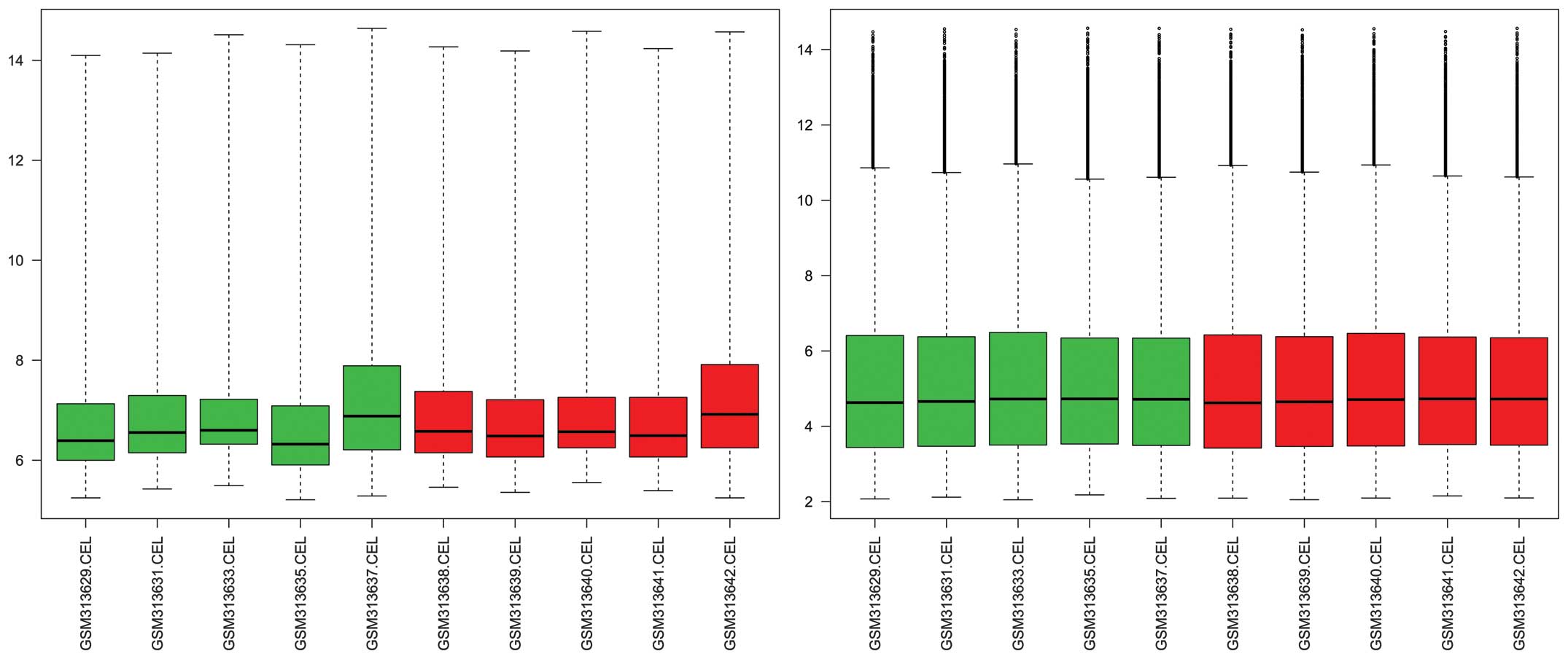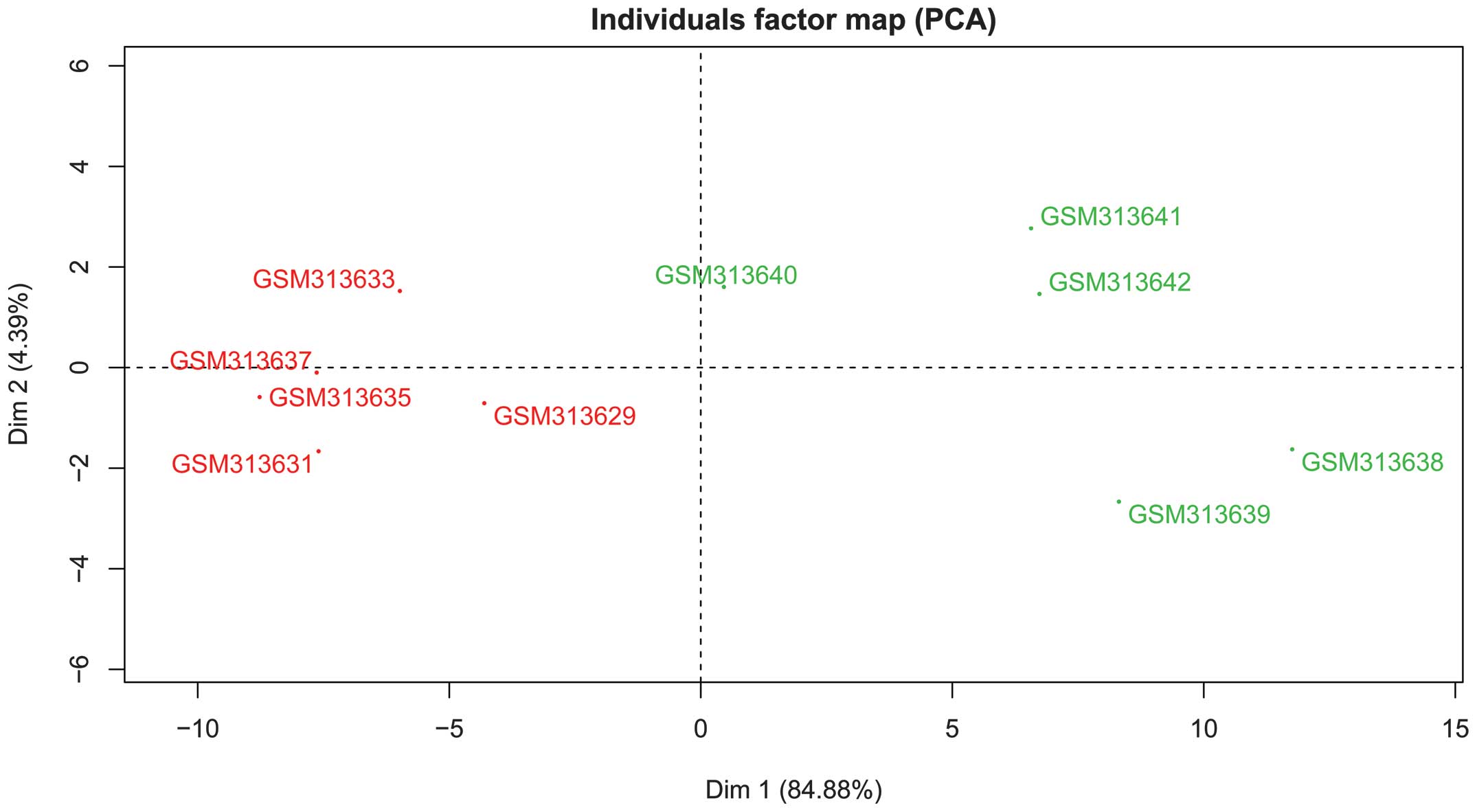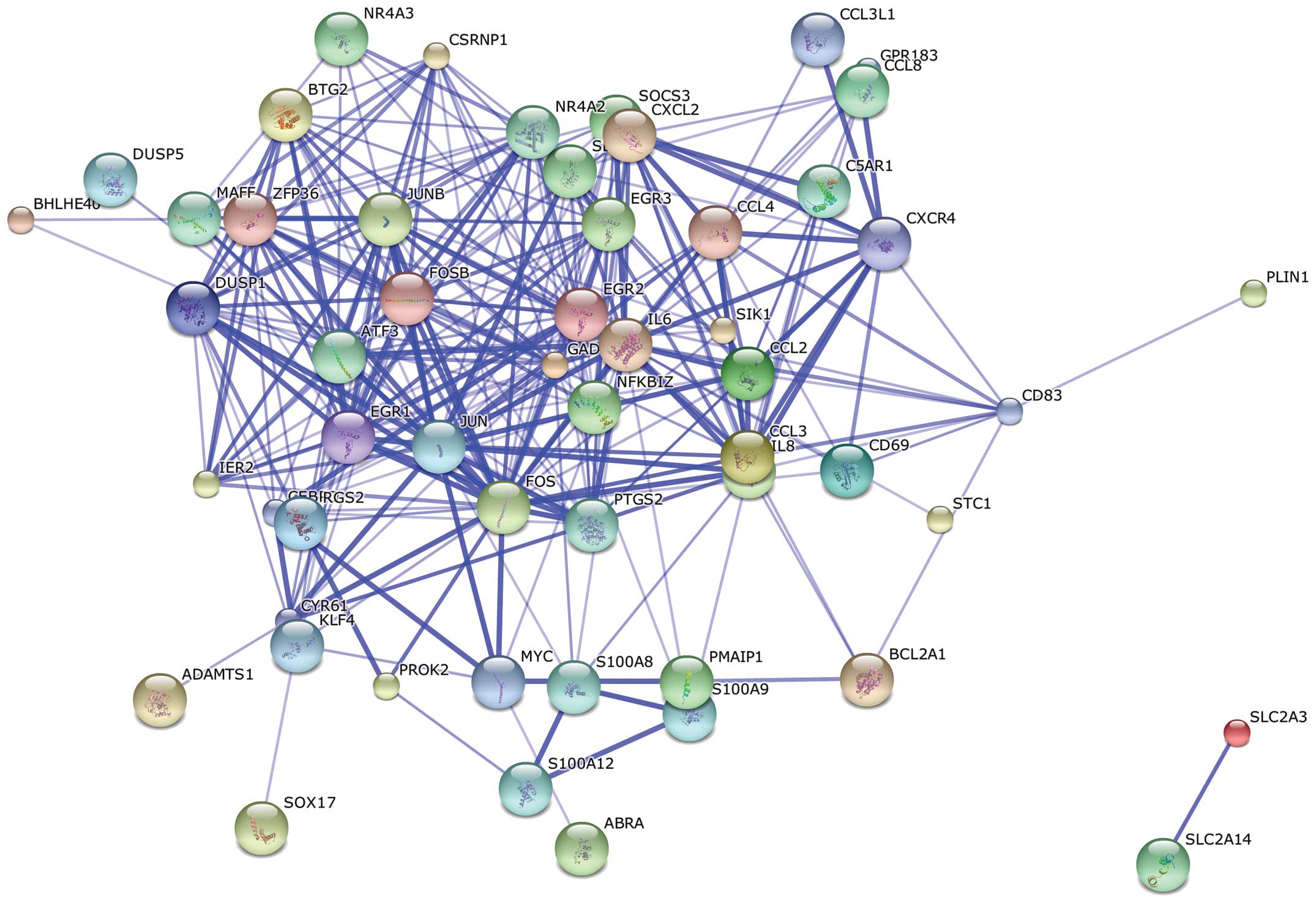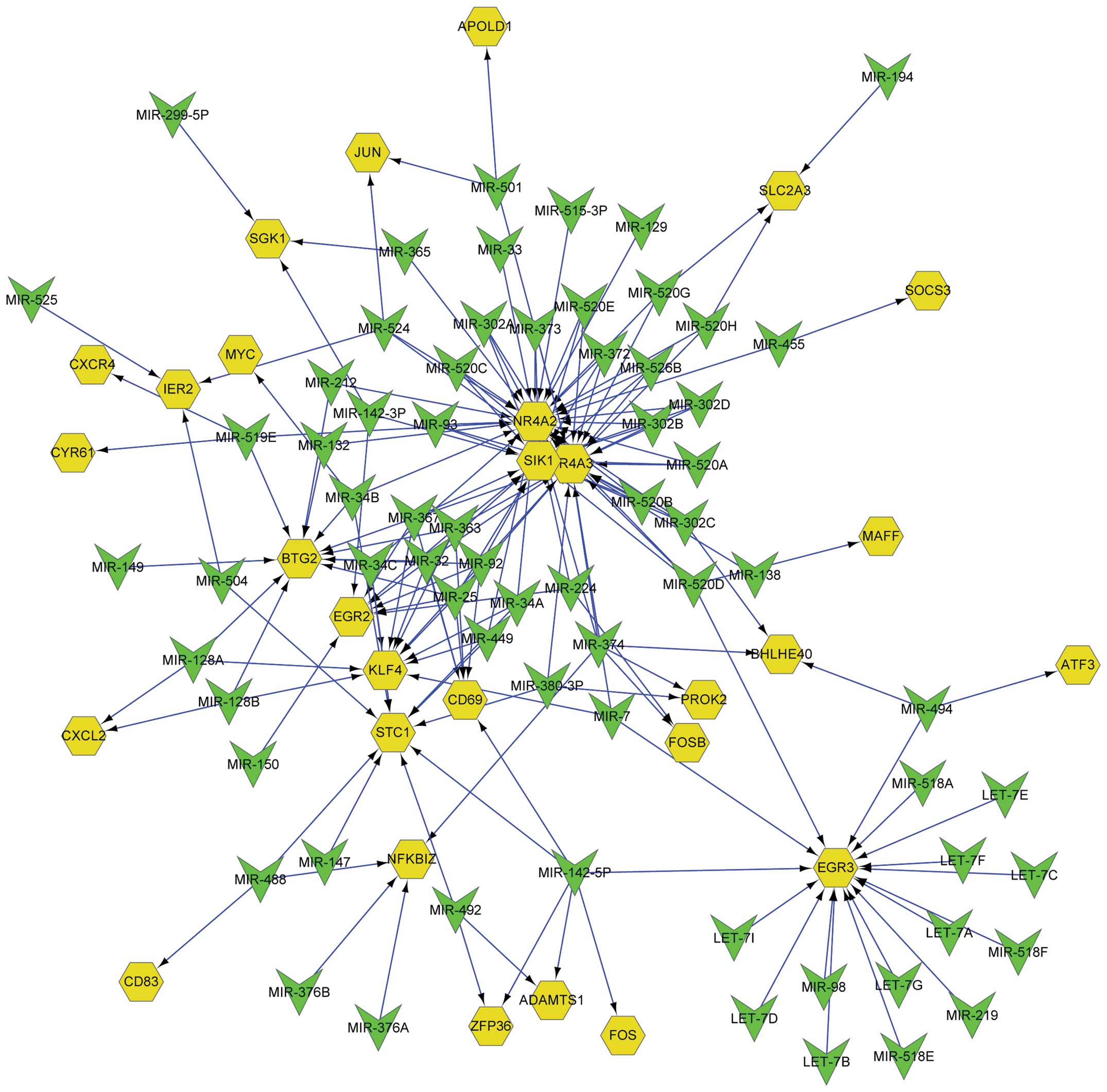|
1
|
Worthley SG, Osende JI, Helft G, Badimon
JJ and Fuster V: Coronary artery disease: Pathogenesis and acute
coronary syndromes. Mt Sinai J Med. 68:167–181. 2001.PubMed/NCBI
|
|
2
|
Nalysnyk L, Fahrbach K, Reynolds MW, Zhao
SZ and Ross S: Adverse events in coronary artery bypass graft
(CABG) trials: A systematic review and analysis. Heart. 89:767–772.
2003. View Article : Google Scholar : PubMed/NCBI
|
|
3
|
Kim NY, Shim JK, Bang SO, Sim JS, Song JW
and Kwak YL: Effects of ulinastatin on coagulation in high-risk
patients undergoing off-pump coronary artery bypass graft surgery.
Korean J Anesthesiol. 64:105–111. 2013. View Article : Google Scholar : PubMed/NCBI
|
|
4
|
Arab S, Konstantinov IE, Boscarino C,
Cukerman E, Mori A, Li J, Liu PP, Redington AN and Coles JG: Early
gene expression profiles during intraoperative myocardial
ischemia-reperfusion in cardiac surgery. J Thorac Cardiovasc Surg.
134:74–81.e2. 2007. View Article : Google Scholar : PubMed/NCBI
|
|
5
|
Gabrielsen A, Lawler PR, Yongzhong W,
Steinbrüchel D, Blagoja D, Paulsson-Berne G, Kastrup J and Hansson
GK: Gene expression signals involved in ischemic injury,
extracellular matrix composition and fibrosis defined by global
mRNA profiling of the human left ventricular myocardium. J Mol Cell
Cardiol. 42:870–883. 2007. View Article : Google Scholar : PubMed/NCBI
|
|
6
|
Konstantinov IE, Coles JG, Boscarino C,
Takahashi M, Goncalves J, Ritter J and Van Arsdell GS: Gene
expression profiles in children undergoing cardiac surgery for
right heart obstructive lesions. J Thorac Cardiovasc Surg.
127:746–754. 2004. View Article : Google Scholar : PubMed/NCBI
|
|
7
|
Chandrasekar B, Mitchell DH, Colston JT
and Freeman GL: Regulation of CCAAT/Enhancer binding protein,
interleukin-6, interleukin-6 receptor, and gp130 expression during
myocardial ischemia/reperfusion. Circulation. 99:427–433. 1999.
View Article : Google Scholar : PubMed/NCBI
|
|
8
|
Tomic V, Russwurm S, Möller E, Claus RA,
Blaess M, Brunkhorst F, Bruegel M, Bode K, Bloos F, Wippermann J,
et al: Transcriptomic and proteomic patterns of systemic
inflammation in on-pump and off-pump coronary artery bypass
grafting. Circulation. 112:2912–2920. 2005.PubMed/NCBI
|
|
9
|
Ghorbel MT, Cherif M, Mokhtari A, Bruno
VD, Caputo M and Angelini GD: Off-pump coronary artery bypass
surgery is associated with fewer gene expression changes in the
human myocardium in comparison with on-pump surgery. Physiol
Genomics. 42:67–75. 2010. View Article : Google Scholar : PubMed/NCBI
|
|
10
|
Lan YF, Chen HH, Lai PF, Cheng CF, Huang
YT, Lee YC, Chen TW and Lin H: MicroRNA-494 reduces ATF3 expression
and promotes AKI. J Am Soc Nephrol. 23:2012–2023. 2012. View Article : Google Scholar : PubMed/NCBI
|
|
11
|
Wang X, Zhang X, Ren XP, Chen J, Liu H,
Yang J, Medvedovic M, Hu Z and Fan GC: MicroRNA-494 targeting both
proapoptotic and antiapoptotic proteins protects against
ischemia/reperfusion-induced cardiac injury. Circulation.
122:1308–1318. 2010. View Article : Google Scholar : PubMed/NCBI
|
|
12
|
Wang Z, Shao J, Zhou Q, Liu J, Zhu Y, Yang
J and Wei M: The −251A>T polymorphism of interleukin-8 is
associated with longer mechanical ventilation and hospital staying
after coronary surgery. Cytokine. 50:268–272. 2010. View Article : Google Scholar : PubMed/NCBI
|
|
13
|
Nathan N, Preux PM, Feiss P and Denizot Y:
Plasma interleukin-4, interleukin-10, and interleukin-13
concentrations and complications after coronary artery bypass graft
surgery. J Cardiothorac Vasc Anesth. 14:156–160. 2000. View Article : Google Scholar : PubMed/NCBI
|
|
14
|
Fromes Y, Daghildjian K, Caumartin L,
Fischer M, Rouquette I, Deleuze P and Bical OM: A comparison of low
vs conventional-dose heparin for minimal cardiopulmonary bypass in
coronary artery bypass grafting surgery. Anaesthesia. 66:488–492.
2011. View Article : Google Scholar : PubMed/NCBI
|
|
15
|
Gautier L, Cope L, Bolstad BM and Irizarry
RA: Affy-analysis of Affymetrix GeneChip data at the probe level.
Bioinformatics. 20:307–315. 2004. View Article : Google Scholar : PubMed/NCBI
|
|
16
|
Diboun I, Wernisch L, Orengo CA and
Koltzenburg M: Microarray analysis after RNA amplification can
detect pronounced differences in gene expression using limma. BMC
Genomics. 7:2522006. View Article : Google Scholar : PubMed/NCBI
|
|
17
|
Sartor MA, Tomlinson CR, Wesselkamper SC,
Sivaganesan S, Leikauf GD and Medvedovic M: Intensity-based
hierarchical Bayes method improves testing for differentially
expressed genes in microarray experiments. BMC Bioinformatics.
7:5382006. View Article : Google Scholar : PubMed/NCBI
|
|
18
|
Jolliffe I: Principal component analysis.
Encyclopedia of Statistics in Behavioral Science. Everitt BS and
Howell D: (New York, NY). John Wiley & Sons. 2005. View Article : Google Scholar
|
|
19
|
da Huang W, Sherman BT and Lempicki RA:
Systematic and integrative analysis of large gene lists using DAVID
bioinformatics resources. Nat Protoc. 4:44–57. 2009. View Article : Google Scholar : PubMed/NCBI
|
|
20
|
Franceschini A, Szklarczyk D, Frankild S,
Kuhn M, Simonovic M, Roth A, Lin J, Minguez P, Bork P, von Mering C
and Jensen LJ: STRING v9.1: Protein-protein interaction networks,
with increased coverage and integration. Nucleic Acids Res.
41:D808–D815. 2013. View Article : Google Scholar : PubMed/NCBI
|
|
21
|
Subramanian A, Tamayo P, Mootha VK,
Mukherjee S, Ebert BL, Gillette MA, Paulovich A, Pomeroy SL, Golub
TR, Lander ES and Mesirov JP: Gene set enrichment analysis: A
knowledge-based approach for interpreting genome-wide expression
profiles. Proc Natl Acad Sci USA. 102:15545–15550. 2005. View Article : Google Scholar : PubMed/NCBI
|
|
22
|
Shannon P, Markiel A, Ozier O, Baliga NS,
Wang JT, Ramage D, Amin N, Schwikowski B and Ideker T: Cytoscape: A
software environment for integrated models of biomolecular
interaction networks. Genome Res. 13:2498–2504. 2003. View Article : Google Scholar : PubMed/NCBI
|
|
23
|
Jaffer I, Riederer M, Shah P, Peters P,
Quehenberger F, Wood A, Scharnagl H, März W, Kostner KM and Kostner
GM: Expression of fat mobilizing genes in human epicardial adipose
tissue. Atherosclerosis. 220:122–127. 2012. View Article : Google Scholar : PubMed/NCBI
|
|
24
|
Lei P, Baysa A, Nebb HI, Valen G, Skomedal
T, Osnes JB, Yang Z and Haugen F: Activation of Liver X receptors
in the heart leads to accumulation of intracellular lipids and
attenuation of ischemia-reperfusion injury. Basic Res Cardiol.
108:3232013. View Article : Google Scholar : PubMed/NCBI
|
|
25
|
Wu C, Gong Y, Yuan J, Zhang W, Zhao G, Li
H, Sun A, Hu Kai Zou Y and Ge J: microRNA-181a represses
ox-LDL-stimulated inflammatory response in dendritic cell by
targeting c-Fos. J Lipid Res. 53:2355–2363. 2012. View Article : Google Scholar : PubMed/NCBI
|
|
26
|
Levy JH and Tanaka KA: Inflammatory
response to cardiopulmonary bypass. Ann Thorac Surg. 75(Suppl):
S715–S720. 2003. View Article : Google Scholar : PubMed/NCBI
|
|
27
|
Junttila MR, Li SP and Westermarck J:
Phosphatase-mediated crosstalk between MAPK signaling pathways in
the regulation of cell survival. FASEB J. 22:954–965. 2008.
View Article : Google Scholar : PubMed/NCBI
|
|
28
|
Kobayashi M, Takeyoshi I, Yoshinari D,
Matsumoto K and Morishita Y: P38 mitogen-activated protein kinase
inhibition attenuates ischemia-reperfusion injury of the rat liver.
Surgery. 131:344–349. 2002. View Article : Google Scholar : PubMed/NCBI
|
|
29
|
Vassalli G, Milano G and Moccetti T: Role
of mitogen-activated protein kinases in myocardial
ischemia-reperfusion injury during heart transplantation. J
Transplant. 2012:9289542012. View Article : Google Scholar : PubMed/NCBI
|
|
30
|
Mathew GM, Mathew DC, Lo SC, Alexios GM,
Yang JC, Sashikumar JM, Shaikh TM and Huang CC: Synergistic
collaboration of gut symbionts in Odontotermes formosanus
for lignocellulosic degradation and bio-hydrogen production.
Bioresour Technol. 145:337–344. 2013. View Article : Google Scholar : PubMed/NCBI
|
|
31
|
Mazandarani M, Mojtahedzadeh M,
Yousefshahi F and Hamishehkar H: Effect of pre-treatment with
hypertonic saline on IL-10/IL-6 ratio in CABG patient. Res Pharm
Sci. 7:S8862012.
|
|
32
|
Schuringa JJ, Timmer H, Luttickhuizen D,
Vellenga E and Kruijer W: c-Jun and c-Fos cooperate with STAT3 in
IL-6-induced transactivation of the IL-6 response element (IRE).
Cytokine. 14:78–87. 2001. View Article : Google Scholar : PubMed/NCBI
|
|
33
|
Gilchrist M, Thorsson V, Li B, Rust AG,
Korb M, Roach JC, Kennedy K, Hai T, Bolouri H and Aderem A: Systems
biology approaches identify ATF3 as a negative regulator of
Toll-like receptor 4. Nature. 441:173–178. 2006. View Article : Google Scholar : PubMed/NCBI
|
|
34
|
Rangnekar VM, Aplin AC and Sukhatme VP:
The serum and TPA responsive promoter and intron-exon structure of
EGR2, a human early growth response gene encoding a zinc finger
protein. Nucleic Acids Res. 18:2749–2757. 1990. View Article : Google Scholar : PubMed/NCBI
|
|
35
|
Lan HY and Chung AC: TGF-β/Smad signaling
in kidney disease. Semin Nephrol. 32:236–243. 2012. View Article : Google Scholar : PubMed/NCBI
|
|
36
|
Lagrange B, Martin RZ, Droin N, Aucagne R,
Paggetti J, Largeot A, Itzykson R, Solary E, Delva L and Bastie JN:
A role for miR-142-3p in colony-stimulating factor 1-induced
monocyte differentiation into macrophages. Biochim Biophys Acta.
1833:1936–1946. 2013. View Article : Google Scholar : PubMed/NCBI
|


















